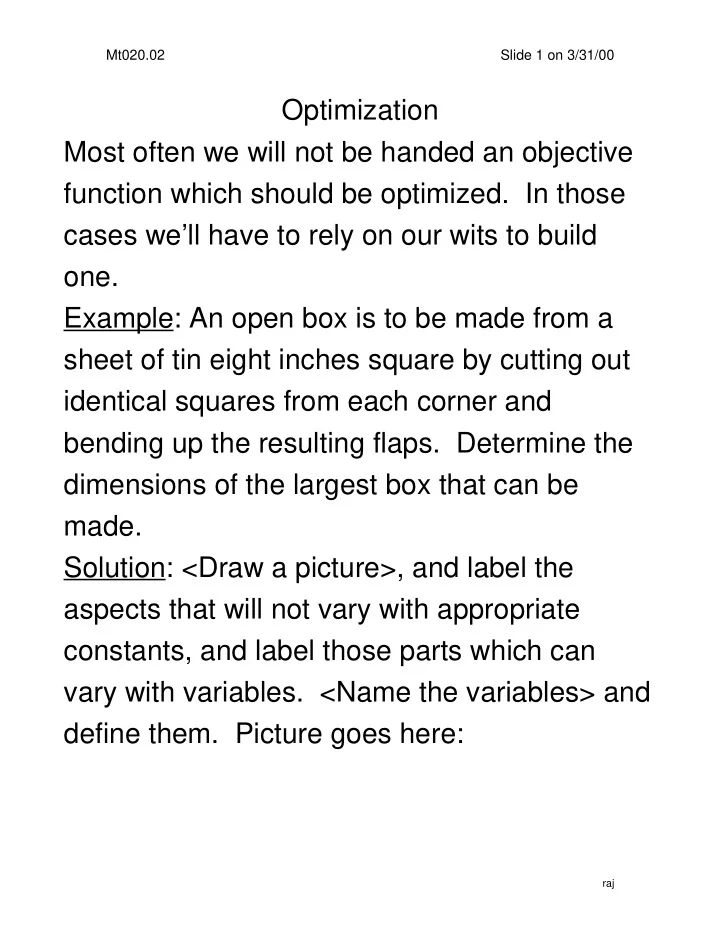

Mt020.02 Slide 1 on 3/31/00 Optimization Most often we will not be handed an objective function which should be optimized. In those cases we’ll have to rely on our wits to build one. Example: An open box is to be made from a sheet of tin eight inches square by cutting out identical squares from each corner and bending up the resulting flaps. Determine the dimensions of the largest box that can be made. Solution: <Draw a picture>, and label the aspects that will not vary with appropriate constants, and label those parts which can vary with variables. <Name the variables> and define them. Picture goes here: raj
Mt020.02 Slide 2 on 3/31/00 Let x =the side length of the square which is removed from each corner. <Build the objective function> which describes the quantity to be optimized. Here we are to maximize the box’s volume. Notice that by changing x, we indirectly change the volume contained by the box. V, the volume, is a function of x. V(x) = (8 - 2x) 2 (x) = 64x - 32x 2 + 4x 3 <Limit the domain to conform to the model> Which values for x are we allowing? We must have 0 ≤ x ≤ 4, in order for our box model to make sense. raj
Mt020.02 Slide 3 on 3/31/00 We are now at the point where we are used to being, namely our problem is Maximize V(x) = 64x - 32x 2 + 4x 3 over the interval [0,4]. Differentiate to get V’(x) = 64 - 64x + 12x 2 which factors as V’(x) = 4(3x – 4)(x – 4). We see that the critical points of V lying in our special domain [0,4] are 4, and 4/3, so we add the endpoints into the mix and come up with our candidate (x) basket {0 , 4/3 , 4} and when we apply the original function (V) individually to items in this basket we get {0 , 37.926 , 0} showing that x = 4/3 is that x value yielding a maximal volume. So to build the biggest box, we should cut a square 1.33 inches on a side from each corner. Which values of x provide the smallest box? raj
Mt020.02 Slide 4 on 3/31/00 Example: Imagine your job is to design a beer can which holds exactly 12 ounces of beer (this is just 336 cubic centimeters). Your beer can must be a cylinder, with a top and bottom, and you must use the minimum amount of aluminum in the manufacturing process. How should you design it? Solution: <Draw a picture>. Picture here: <Label it with constants and variables>. The can has two variables, r = the radius of the circular end disks, and h = the height of the cylindrical can itself. <Build the objective function> We are to minimize the total amount of aluminum used so raj
Mt020.02 Slide 5 on 3/31/00 we begin with Alum. (A) used = (A for sides) + (A for ends) = (2 π r)h + 2( π r 2 ) so we get A = 2 π rh + 2 π r 2 = 2 π r (h + r). Note that our objective function has two variables in it (r and h) and we only work with one. We now need to work to express h in terms of f, thereby eliminating h from our objective function. How can we link h and r in an equation to facilitate this goal? Well if h and r were truly independent, we could say increase them both simultaneously. What prevents us from doing that? Our volume must remain at 336 cubic centimeters. Indeed the volume of our proposed can is 336 = V = π r 2 h and this is the required link joining h and r. We solve it for h raj
Mt020.02 Slide 6 on 3/31/00 and get h = 336 / ( π r 2 ), and now we can rewrite our objective function A = 2 π r (h + r) = 2 π r ((336 / ( π r 2 )) + r). = 672 / r + 2 π r 2 A(r) = 672 r -1 + 2 π r 2 <objective fcn> <limits on domain?> We must restrict r to live in the interval (0 , ∞ ). Critical points of A occur where the derivative A’ = 0 or else where A’ d.n.e. Note there are no weird (A’ dne) critical pts on our domain. A’ will = 0 when 0 = A’(r) = -672 r -2 + 4 π r or in other words when r 3 = 672 / (4 π ). This reduces to r = 3.767 cm and then h = 7.535 cm (=2r). Why aren’t beer cans designed in these proportions? raj
Recommend
More recommend